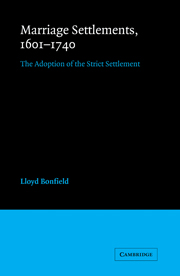Book contents
- Frontmatter
- Contents
- List of tables
- Preface
- List of abbreviations
- Introduction
- 1 The medieval inheritance and the Statute of Uses
- 2 Law in transition: the conflict over restraints upon alienation
- 3 Patterns of marriage settlement 1601–1659: the development of the ‘life estate-entail’ mode
- 4 The emergence of the strict settlement
- 5 The adoption of the strict settlement 1660–1740: Kent and Northamptonshire
- 6 Marriage settlements in perspective: the social and economic aspects
- Conclusion
- Bibliography
- Index
- CAMBRIDGE STUDIES IN ENGLISH LEGAL HISTORY
4 - The emergence of the strict settlement
Published online by Cambridge University Press: 07 October 2011
- Frontmatter
- Contents
- List of tables
- Preface
- List of abbreviations
- Introduction
- 1 The medieval inheritance and the Statute of Uses
- 2 Law in transition: the conflict over restraints upon alienation
- 3 Patterns of marriage settlement 1601–1659: the development of the ‘life estate-entail’ mode
- 4 The emergence of the strict settlement
- 5 The adoption of the strict settlement 1660–1740: Kent and Northamptonshire
- 6 Marriage settlements in perspective: the social and economic aspects
- Conclusion
- Bibliography
- Index
- CAMBRIDGE STUDIES IN ENGLISH LEGAL HISTORY
Summary
In the preceding chapter, the manner in which the alteration in the attitude of the common law courts towards the manipulation of contingent remainders facilitated the emergence of the life estateentail form of marriage settlement during the first half of the seventeenth century has been demonstrated. At the same time, however, the precarious nature of the entail which this mode of settlement conferred upon the eldest son produced by the marriage has been noted. Under the rules of destructibility of contingent remainders, a complex body of law established to ensure that these future interests were not employed to create long-term restraints upon alienation, a forfeiture or tortious feoffment by the life tenant in possession would defeat the contingent entail settled upon the male heir produced by the marriage. Essentially, then, what the common law courts had sanctioned was the transfer of the patrimony from one generation to the next by marriage settlement; but they had adamantly refused to restrain the freedom of disposition of the tenant in possession to insure that the entail descended unimpinged to the next generation. Around the middle of the seventeenth century, conveyancers developed a device by which they sought to secure this entail in the male heir – the trust to preserve contingent remainders. In this chapter, the origins of the device will be traced, and the elaboration of legal doctrine regarding the nature of the innovation in the courts of common law and equity will be considered.
- Type
- Chapter
- Information
- Marriage Settlements, 1601–1740The Adoption of the Strict Settlement, pp. 55 - 81Publisher: Cambridge University PressPrint publication year: 1983
- 1
- Cited by

